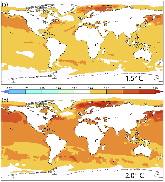Changes in tropical cyclones under stabilized 1.5 and 2.0°C global warming scenarios as simulated by the Community Atmospheric Model under the HAPPI protocols
- Lawrence Berkeley National Lab. (LBNL), Berkeley, CA (United States)
- Stony Brook Univ., NY (United States)
The United Nations Framework Convention on Climate Change (UNFCCC) invited the scientific community to explore the impacts of a world where anthropogenic global warming is stabilized at only 1.5°C above preindustrial average temperatures. We present a projection of future tropical cyclone statistics for both 1.5 and 2.0°C stabilized warming scenarios by direct numerical simulation using a high resolution global climate model. As in similar projections at higher warming levels, we find that even at these low warming levels the most intense tropical cyclones becomes more frequent and more intense, while simultaneously the frequency of weaker tropical storms is decreased. We also conclude that in the 1.5°C stabilization, the effect of aerosol forcing changes complicates the interpretation of greenhouse gas forcing changes.
- Research Organization:
- Lawrence Berkeley National Lab. (LBNL), Berkeley, CA (United States)
- Sponsoring Organization:
- USDOE Office of Science (SC)
- Grant/Contract Number:
- AC02-05CH11231; SC0016605
- OSTI ID:
- 1525259
- Journal Information:
- Earth System Dynamics, Vol. 9, Issue 1; ISSN 2190-4979
- Publisher:
- European Geosciences UnionCopyright Statement
- Country of Publication:
- United States
- Language:
- English
Similar Records
Changes in extremely hot days under stabilized 1.5 and 2.0 °C global warming scenarios as simulated by the HAPPI multi-model ensemble
Midlatitude atmospheric circulation responses under 1.5 and 2.0 °C warming and implications for regional impacts








